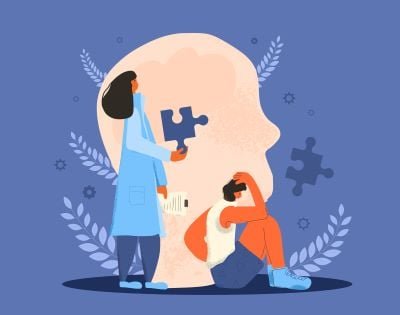How to Go Deeper with Your OCD Research Data |

Inconsistent results across studies present a challenge not only for conceptual understanding of clinical symptoms but also for advancing treatment. For example, a meta-analysis sought to resolve discrepancies across over 100 studies about deficits in executive function in individuals diagnosed with obsessive-compulsive disorder (OCD). This meta-analysis concluded that OCD is associated with broad deficits in executive function but did not necessarily point to specific cognitive processes that could be studied further or considered as potential treatment targets. When traditional analytic methods fail to provide much needed specificity, how can researchers make sense of mixed findings? Greater measurement precision is one path forward, something that computational modeling can be powerfully leveraged to achieve.
Computational approaches broadly involve using mathematical equations to develop mechanistic models of brain-behavior associations. These approaches generally fall into two camps: data-driven and theory-driven, which have separate goals of prediction and interpretation, respectively. In my research, I use theory-driven computational modeling to study neurocognitive processes implicated in compulsivity, a maladaptive transdiagnostic trait that is a hallmark symptom of OCD.
I have seen firsthand how theory-driven computational models can be used to reveal information that is not apparent from using traditional analytic methods. A commonly used experimental paradigm called the beads task has been used extensively in the OCD literature with mixed results. In this task, participants draw beads from a hidden jar to aid in guessing the color of the majority of beads in the jar. The number of beads selected before making a choice about the jar’s identity is often considered to be a behavioral measure of propensity for information sampling. Excessive information sampling is clinically relevant, as it can manifest as psychiatric symptoms such as compulsive checking in OCD or repetitive reassurance seeking in anxiety disorders. Confusingly, individuals with OCD have been shown to select more, fewer, and the same number of beads compared to healthy controls, leading to challenges in interpreting findings from this task.
In the Columbia University Center for OCD and Related Disorders, the research lab I am affiliated with, we collected data using the beads task from individuals diagnosed with OCD or an anxiety disorder and healthy controls. At first pass, there were no discernable differences in task behavior between individuals with a clinical diagnosis and healthy controls. In a study presented at the ADAA 2022 Annual Conference, we re-analyzed the data using theory-driven computational models of inference and value-based decision-making to examine the mechanisms of how trait anxiety influenced information sampling behavior on this task. Whereas initially we thought our dataset represented yet another inconclusive study using the beads task in individuals with OCD, theory-driven computational modeling provided the greater measurement precision needed to meaningfully link neurocognitive processes with observable behaviors.
If you are inspired to use computational approaches in your own research on psychiatric disorders, I have two recommendations. First, explore the literature outside the clinical area you specialize in. For me, it has been particularly helpful to gain broad knowledge of computational models across units of analysis and in samples ranging from animal models to healthy individuals to patients. Second, collaboration is crucial. Partnering with experts in computational modeling has been critical to furthering my ability to apply and interpret computational models in my own research. Although I am still early in my path toward becoming a sophisticated user of these methods, I appreciate the vast potential of using computational modeling to improve clinical outcomes for patients with OCD and other psychiatric disorders. As the field moves toward increased personalization of assessment and treatment, computational approaches might be the key for going deeper with our data.
This post is presented in collaboration with ADAA’s OCD and Related Disorders SIG. Learn more about the SIG.
Source link
#Deeper #OCD #Research #Data

